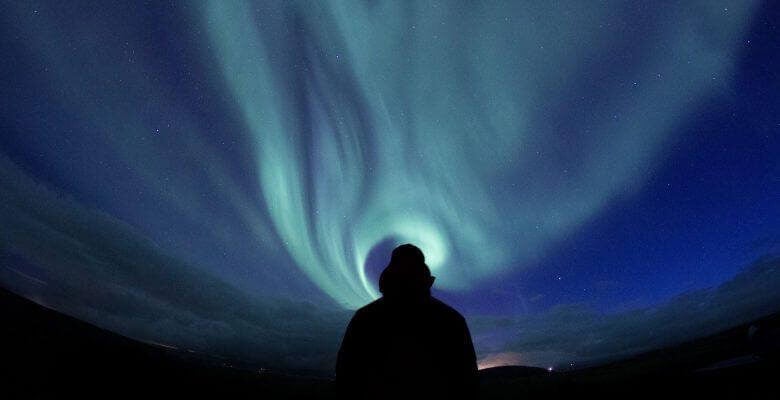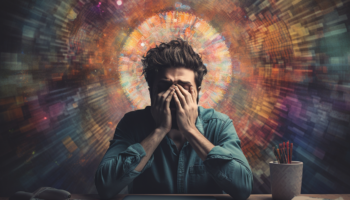For such a simple activity, meditation is notoriously complicated. You need nothing to meditate: no special garb, no esoteric trinkets, no supervision. Yet, when the time comes to just sit, to calm and observe the mind, many are stunned and overcome by the inevitable flood of thoughts.
Thoughts of worry, thoughts of self, and thoughts of thoughts, all spring to the front of your attention. Perhaps the first real challenge of cultivating a meditation practice is realizing what exactly you are trying to do.
Embarking on a psychedelic experience, on the other hand, is overwhelming in a different way. If meditation sets you on the arduous path toward the center of conscious experience, psychedelics transport you directly into the thick of it. Psychedelics, after all, are often considered a shortcut to some of the insights reached through meditation.
There is some truth to this idea of psychedelics as a shortcut, but it carries misconceptions about both psychedelics and meditation. Consciousness is an elusive yet ever-present phenomenon that can be explored in many ways—using one method to skip another overlooks the compounding effect of using both, together.
Psychedelics, meditation, and the default mode network
Thanks to advanced brain scanning technology, researchers have been able to observe and map neurological changes in altered conscious states. Some of the most interesting results come from studies where patients use psychedelics or entered meditative states. These studies confirm the common anecdotal reports of both experiences and provide a scientific explanation for the feeling of ego dissolution.
Before discussing the neurological overlap of psychedelics and meditation, we must first explain an area of our brain known as the default mode network (DMN). The default mode network is aptly named. This part of our minds is active when we remember, plan, and self-reflect. It helps constitute our sense of self. By no coincidence, the DMN is often overactive in depressed patients, who struggle to stop thinking about themselves in a negative light.
The DMN accounts for our normal, everyday thinking patterns that protect our sanity. At the same time, the DMN confines us to our everyday insanity.
A comparative study examined different brain scans of people using LSD, psilocybin, and ayahuasca, and compared them to brain scans of people in meditative states. In psychedelic and meditative brain states, the researchers found similar alterations in the DMN. While not all psychedelic substances and types of meditation interact with the DMN in the same way, the brain scans have demonstrated that both techniques consistently disrupt our DMN and sense of self.
From a subjective perspective, the changes in the DMN related to meditation and psychedelic use are accompanied by feelings of peace, moments of insight, and internal transformation. They are also consistent with findings that meditation and substances like LSD or MDMA can be used to treat depression and anxiety. If the experiential anecdotes aren’t enough, now science is joining the argument that psychedelics and meditation are two sides of the same coin.
Listen to our podcast episode with Tao Lin talking about: What Is The Optimal Setting For Microdosing? or Click here to read the transcript
What are you trying to do?
There are different psychedelics and different types of meditation. Before pursuing psychedelic meditation, you should consider where you are and where you want to be. Depending on your individual experience, one psychedelic may be a better option than another.
For instance, combining marijuana with meditation may be markedly different than MDMA meditation. The dosage amount, too, will significantly alter your meditation. While a low dose of marijuana combined with meditation is an experience you can direct and control, a full-blown ayahuasca trip is an entirely different type of meditation that may have to control you instead. At some point, the lines may even blur between the two practices.
Techniques for Psychedelic Meditation
No matter how you decide to approach psychedelic meditation, there are a few techniques that can support the experience.
Mise en place
Preparation is key when using psychedelics. Psychedelics are more enjoyable and manageable when you enter with an open, ready mind. When you add meditation to the mix, that mental lightness is even more critical. With adequate preparation, when the time comes to surrender to the experience, you will do so with ease.
Maintain a consistent meditation practice beforehand. Without a healthy practice, someone trying to meditate with psychedelics will be in two unfamiliar territories, instead of just one. A lack of preparation may end up frustrating or derailing you.
You can take additional steps in your diet and lifestyle. For example, it is common in ayahuasca ceremonies to refrain from sex, drugs, alcohol, and even certain foods. There’s a physical reason for this, but these steps also frame the experience and bring it to focus.
Ease in
There are psychedelics, there is meditation, and there is psychedelic meditation. If you are concerned about a substance taking over your meditation, ease into your dosage, cut it down to less than you think, and work your way upwards from there. Find your balance.
In your first attempt to meditate, a full dose of LSD may be too much to handle. You can lower the amount, or even try to use another substance instead. Marijuana edibles are common to pair with meditation. The delayed onset of effects and more regulated doses makes it easier to manage than many other substances, which is especially helpful with mindfulness meditation.
Mind your meditation
Some substances may be more suitable for your preferred type of meditation.
MDMA, for example, strongly influences your physical senses. Instead of meditating on some internal, mental processes, it may work better with meditation that involves external stimuli. For instance, you can meditate upon a piece of music, some visual stimulation, or even incorporate a physical practice like yoga or breath work. These types of meditation bring out the effects of a substance like MDMA, highlighting them as the intentional focus of the trip.
Marijuana or lower doses of psychedelics like psilocybin, LSD, or ayahuasca can work well with directed types of meditation. They can enhance meditation techniques like mindfulness, contemplative meditation, and mantra repetition without hijacking the experience.
Depending on your substance and personal meditation practice, adapt and adjust your approach to what you think will work best.
Take a cue from the experts
Many therapists who treat with psychedelics use the same method, which is simple and effective. They provide a comfortable physical setting, put on relaxing music or ambience, and then get out of the way. Find yourself a welcoming place to sit or rest; somewhere you can imagine settling into for a while. Having an unobtrusive soundtrack or background audio can help you anchor your attention.
If you have company during the experience, make sure they aren’t trying to lead you to any particular conclusion or end. If you are going alone, the same idea applies to yourself. Maintain focus, approach it lightly, and don’t force yourself.
Tantalus
Trying to harness the mind in meditation is a bit like holding a water wiggly—those tubular, slippery, jelly-filled toys that leap out of your hand whenever you try to hold onto them. With the addition of a psychedelic state of mind, it could be like grasping with a greased hand.
Too many goals and intentions can become a roadblock to learning and growth. It is essential to observe and define your desires from psychedelic meditation, and perhaps to abandon them entirely. While there are techniques that can help with your psychedelic meditation, you should not regard them as ways to “get you there.” Instead, use these techniques and considerations to get out of your own way.
If you want to find out more about the topic check out our podcast interview with Dr. Jennie Rivlin Ph.D. where we talk about The power of meditation and microdosing to spark a mystical experience capable of counteracting a lifetime of skepticism or Click here to read the transcript
Learn more about integrating psychedelics into your life in our online Microdosing Course.








The story of Ram Dass (Dr. Richard Alpert) comes up in which he gave his Guru (Neem Karoli Baba) a reported 900 Micrograms of LSD for a first experience, and… Nothing beyond a “twinkle” in the Guru’s eyes resulted. On a second occasion and even higher dose was requested and the tablets were explicitly chewed and swallowed, extinguishing any doubt’s Ram Dass had about whether the LSD was actually consumed, the result was the same.
If the result, or goal of “meditation” is to find one’s actual identity as consciousness, and if consciousness is constant and eternally unchanged by the contents of experience, as Sages report, then, it ought to be possible to observe the psychedelic experience in meditation as just that, an experience in awareness rather than…
“I am completely overwhelmed and at the mercy of this psychedelic.”
Psychedelic: “mind manifesting.”
Are we the mind, or are we Consciousness, in which, mind and all experiences and states, including psychedelic states, appear?
I realize these ideas may be completely foreign to most, and in fairness this is an advanced level of self realization available to someone like Neem Karoli Baba.
This article is emphasizes, starting low and taking “baby steps” with cannabis and “easing in.” There can be no question that meditation in a psychedelic state is for the experienced explorer, one for whom substance, set, and context and are as familiar and inescapable as the breath.
Beautifully said. Thank you.
I wish I could work for Third Wave but I am still in school. Psychedelics are my passion. I want to help change the world with them. I hope one day I will be able to work with you all. Thank you for doing this.
Goodday,
I have done some personal speculation and i think i know the answer to why DMT does what it does.
Lets start with why its in our brain to begin with, DMT increases the processing capability of sensory function, as it makes you see colours in white lights it makes sounds more vibrant and feeling more intense. Knowing this i can suggest that these molecules are the main reason our brains process this information in the first place.
Think of it like this, we constantly produce DMT in our body’s and constantly consume it by using our sensory function. Knowing this it would be pretty obvious why there is more DMT found in dead/dying people for the simple fact that they would no longer use their sensory function therefore no longer consuming the natural DMT.
If my theory is correct this would mean that molecules like this would be one of the most if not the most important to life in general because without it we would simply not be able to percieve.
I am currently studying why people are able of having a natural DMT “trip” by meditation and i think i have a logical explanation for this, immagine you would focus on your inner mind instead of the outside world stop percieving sounds and lights around you for a prolonged period of time, if DMT is responsible for the processing of sensory information and you would stop percieving for a prolonged time this would mean you’d save up the natural DMT leaving you with more than you need when you get out of trance giving you the natural DMT trip.
Im currently stuck on the subject of why “trip” patterns are mostly in 2 colours a shade of purple and a neon green, this sounds like hallucinations but knowing that 95% of people using these substamces notice the patterns in these colours it is unlikely to be coincidence,
I was wondering if you know anything specific about these 2 colours that could explain this phenomenon? Anyway thank you for listening and i could really use some help/feedback since i am trying to prove the importance of the molecule.
Dear regards,
Wisse Wester
Hi Wisse
The colours of the visible spectrum are associated with various chakras or energy centres in our body. Starting at the base chakra (the base of the spine), you move upwards through six further chakras. Green corresponds to the Heart chakra (associated with Love), and Violet to the Crown chakra (top of the head, associated with Spirituality).
Some might argue that Love is the defining characteristic of God or Infinite Intelligence, and that Spirituality represents the essence of God. So perhaps DMT allows us to experience not only God’s love but also God’s very nature!
Greetings. Thankyou for this info. Please can you help me.
I just saw today a AMAZING ARTICLE ON Meditation with Psilocybe
It was about our shadow side & so much more It just flashed up then disapeared
Truly need to read it & wish to share it!
I am not good with computer stuff. If anyone can find a article that mentioned the Caterpillar
& how The Mushroom
Helped this amazing man to understand. What is happening NOW. PLEASE SEND ME. ANY LINK ! ~~~~ much LOVE & LIGHT. TO ALL WITH THANKS. 🌠🌠🌠
Am a long time meditator but due to cost of retreats and rising expenses have not been able to take extended retreats in recent years. My home practice has slipped, but am still generally happy. But can not access deep states anymore to advance my practice. Am considering microdosing. What I like about meditation over using high doses of psychedelics is in meditation there is the ability to return to normal default brain consciousness when needed. I believe microdosing may have a similar effect for a daily practice.